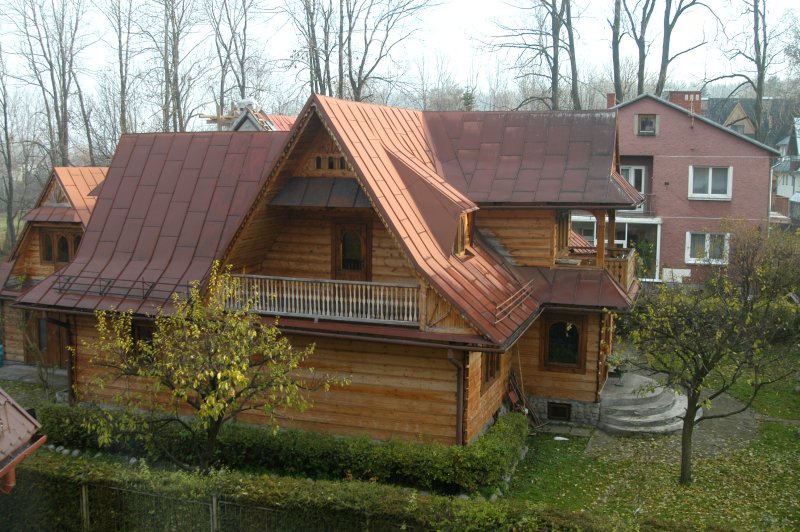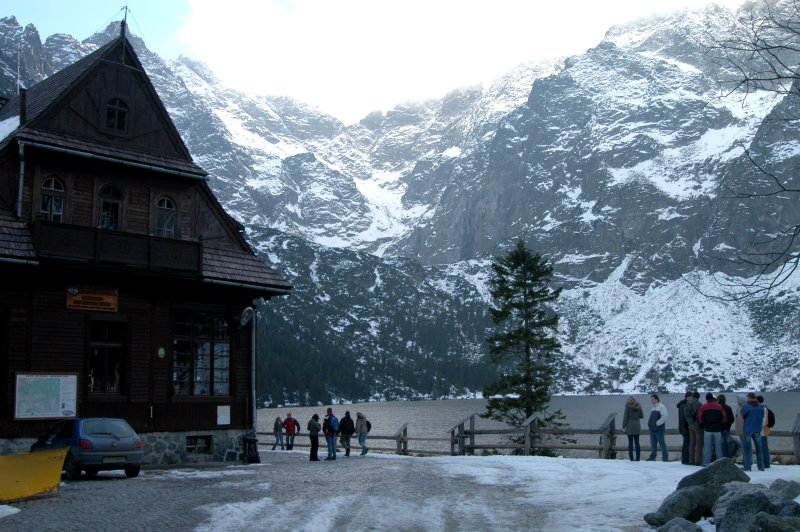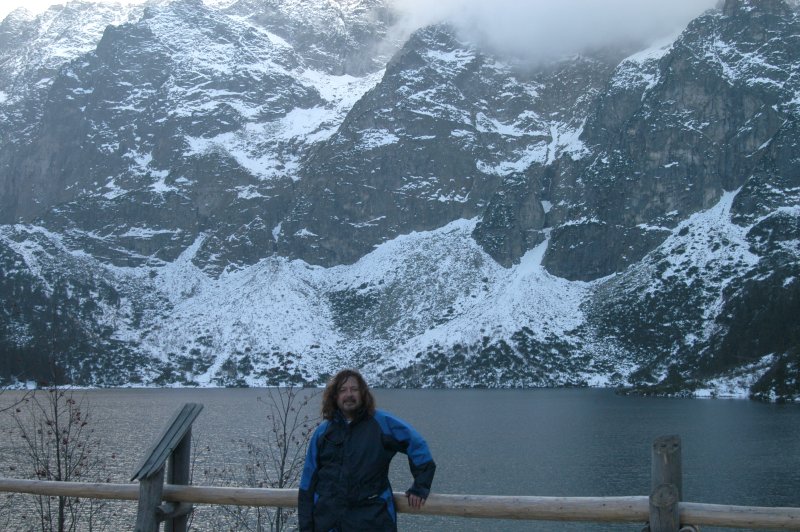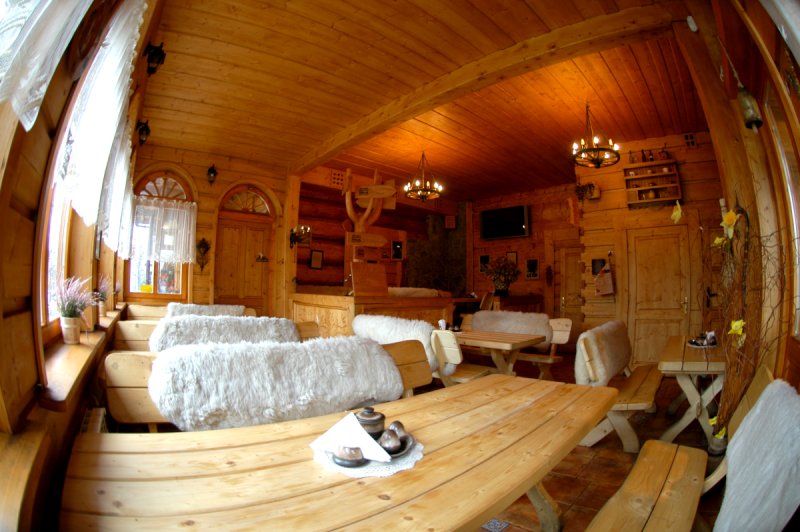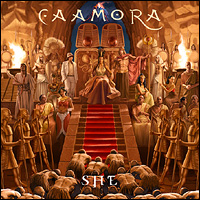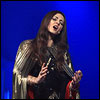|
View from room window at Villa
Slimak, Zakopane. |
|
In the
1870s the purity of its mountain air attracted the attention of doctors
concerning their consumptive city patients. The mountain village became in a
few years a desirable location for the medical world, and artists and
intellectuals soon followed. What became a popular and fashionable site was
soon discovered by the Poles. From the 1920's and 1930's and after World War
II Zakopane became a prime tourist area. Zakopane's main street is a
pedestrian walkway with restaurants and souvenir shops. Numerous fast food eating
facilities like McDonald's and KFC (Kentucky Fried Chicken) have found space
along the street, though I was keen to find more traditional cuisine. I set out
too reconnoitre Krupowki high street, as it was late in the afternoon and
the sun would probably only be out for a few more hours. Though
attractive wooden villas were in evidence, Zakopane architecture is not in
the mould of old Polish towns. It does not possess the masterpieces of
Crakow, nothing special.
Indeed, it looks much like one
would expect any prime tourist ski resort to look like. Built for
purpose, it has a charm nonetheless.
The distinctive Zakopane mountain architectural style
was pioneered by Stanislaw Witkiewicz. The first building ever erected in
the Zakopane style was the Villa "Koliba." Designed by Stanislaw Witkiewicz
and built between 1892 and 1894, it stands to this day on Koscieliska Street
in Zakopane. |
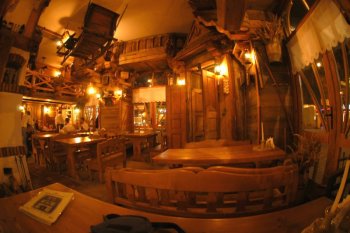 |
|
At the lower end of the pedestrian street
close to where the highway bypasses Zakopane and the river Cicha Woda
flows by, is a marketplace where
craftsmen's and artists' creations are sold. Armed with a map I had acquired
earlier from the tourist office as I alighted from the bus, I found a
route up Walowa Gora, just passed the entrance to a main ski lift
station beyond the market. In fact the route, somewhat muddy and
precariously slippery, reached the overhead lines of the
funicular, near a radio tower. Mist hung in the valley below. The light
began to fade fast around 16h30, so I turned back. Still being
off-season, the town was quieter than normal, yet I would expect it to
be an entirely different proposition, as soon as the first winter
snowfalls occurred. At this time of the year, perhaps not the ideal
place to spend one's birthday. The walk was a good way to flex the
muscles. Numerous elderly women braved the cold to vend cheese rolls to
passers-by from their tiny stalls. After a shower I headed out to grab a
bite. |
|
|
The interior of Karcma Zapiecek, a
restaurant on Krupowki,Zakopane. |
|
|
Zakopane culture
The people in this region are
particularly famous for their
oscypek, a cheese
made from a mix of cow's and sheep's milk. I had
acquired a taste for cabbage-based traditional Polish food and entered
Karcma Zapiecek restaurant on Krupowki, on instinct. I was in luck. I was
greeted upon arrival by a smiling yet shy blonde waitress, dressed in some
sort of traditional costume. Stefcia recommended one of the soups on the
menu, consisting of mutton, vegetables and mushrooms. Delicious, especially
with a glass or two of red wine and not too filling. Zakopane is
not exactly a mecca of high culture, but is home to a
rich folk culture much romanticized in the Polish patriotice imagination.
Goralska muzyka (Highland music) is central to that, with double bass,
guitars, cellos and violins predominating as instruments.
While folk music has largely
died out in Poland, especially in urban areas, the tourist destination of
Podhale has retained its traditions. Though a part of Poland, Podhale's
musical life is more closely related to that found in the Carpathian
mountains of Ukraine and Transylvania.
Several restaurants, including this restaurant, used
resident folk bands to attract tourists, yet they all sounded the same to
me. At that stage I knew nothing of the local culture. My curiosity got the
better of me and as soon as I made an attempt to extend the conversation to
find out more, I seemed to embarrass Stefcia, whose English was probably
limited to the menu. Well, my Polish was non-existent, to be fair. Customers
left and soon I was the last. I retired to the confines of my room,
contemplating the fact that another year had passed on so rapidly. Polish
channels only were to be found on TV. Marek had put paid to my ambitions of
hiking to the summit of Giewont, too dangerous and specialized equipment,
crampons and the like. Heavy snowfalls had occurred at high altitudes.
Indeed, it seemed from the news channel that some sort of mountain rescue
had taken place in the Tatras. In any event, i only had one full day within
which I could use for a day walk. |
|
 |
|
|
Grace and Stefcia, charming
waitresses at Karcma Zapiecek, dressed in costumes of the local Highland
folk culture. |
|
|
|
Morskie Oko
I surfaced fairly early, eager
to make a start for the remote the snow-capped mountains clearly visible
from Zakopane. Next on my list of options was a lake known as Morskie Oko.
The only problem was that the restaurant below only served breakfast at
09h00, for which I had already paid. He assured me that I could easily
manage the trip and walk in a day. Besides, the weather looked good and the
skies were clear and no foul weather was expected until the following day.
So I ordered and tucked into an omelette, not the healthiest but tasty
nonetheless. I walked to the bus station near the main railway station via a
short-cut and took a mini-cab for 7zl, bound for Bialka, at the edge of the
National Park, the journey lasting an hour. |
|
Arriving at Lake Morskie Oko. |
|
|
Morskie
Oko is one of the most popular destinations in the Tatras, often receiving
over 50,000 visitors during the vacation season. It is reached by foot in
about two hours from the nearest road that allows motorized access. Many
other tourists opt to take the journey by horse-drawn cart, a large number
of which are operated by the local Górale inhabitants.
In winter, a short section of the journey is in an avalanche danger zone,
and the area can remain cold and rainy even in summer. I chose to walk the
tarred road which gradually ascended and meandered through the forest of
Swiss pines. The less ambitious hired a cart-ride but many chose the same
option I had. In two hours I had covered the distance to the lake, having
been overtaken by carts only, while my deliberate pace had bewildered some
on foot, or so it seemed to me from the tone of some of the dialogue. It was
sunny, the air fresh, though I hurriedly donned my wind jacket as I breeze
picked up nearer Morskie Oko.
The route to the south, concealed above Morskie Oko
and shut at this
time of the year, the path icy and slippery,
leads to the magnificent Czarny Staw (the Black Lake) higher up the valley.
|
|
 |
|
|
Horse drawn carts operated by
Górale
inhabitants
provide a means of reaching Morskie Oko. |
|
|
C'est moi at Morskie Oko. |
|
|
 |
|
I contented myself instead
with a tea and apple tart at the tea-room adjoining the lake, now
crowded with visitors. Morskie Oko is the fourth deepest lake in the
Tatra mountains. It is situated in the Rybi Potok Valley,
at the base of the Mieguszowiecki Summits, and deep within the Tatra
National Park. The peaks that ring the lake rise about 1,000
meters above its surface; one of them is
Rysy (2,499
meters), the highest peak in the Polish Tatras. Beside Mieguszowiecki
Szczyty (including Mieguszowiecki Wielki, 2,438 meters), farther away
and slightly to the left, is the distinctive, slender Mnich (“Monk,”
2,068 meters). Many Swiss Pines also grow around the lake. In the
past, Morskie Oko was called "Rybie Jezioro" ("Fish Lake") due to its
natural stock of fish, which are uncommon in Tatra lakes and ponds. In
the clear depths of the water, one can easily notice trout
- so called "famine" trout - that live in the lake. The name "Morskie
Oko" translates to "Eye of the Sea", derived from an old legend,
according to which the lake was connected to the sea via an underground
passage. |
|
|
